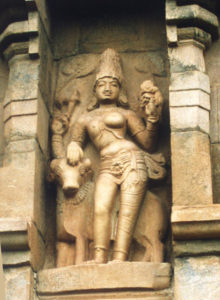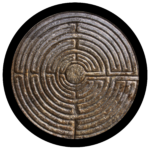Myles Downes
Copyright © June 1997

In reading some of the work done on Jungian ideas surrounding gender, gender construction, gender identity, and the archetype of the Androgyne, I’ve been struck by some of these concepts in regards to my work with transgendered clients. It is my intent with this paper to demonstrate some of the ways in which people who identify as transgender simultaneously embody and confound traditional Jungian gender concepts as they go about constructing their own definitions of what it means to be male, female, or something else entirely in Western culture in the late twentieth century.
Jung proposed a number of possible ways of looking at gender. Key to much of his theorizing in this area were his concepts of the contrasexual other, the anima or animus of the individual. The basic idea is that within every person there exists an archetype of the opposite gender: every woman carries within her the animus archetype of the masculine, and every man carries within himself the anima archetype of the feminine. Jung called this contrasexual other the “soul-image” of the individual, an indication of the great importance he attached to these concepts in the working of the psyche. Related to these but separate is the idea of the Androgyne, an archetype with what I would consider to be two distinct facets which at first glance appear to be somewhat contradictory. Jung believed that some individuals suffered from an incomplete disidentification with the archetype of the Hermaphrodite, the original unbroken state of nondifferentiation, a condition which carried for Jung and his followers a more negative connotation. Simultaneously, he saw in the archetype of the Androgyne a potentially very healthy union of opposites, which he termed the coniunctio. Jung did not necessarily believe that the archetypes of the Androgyne and the Hermaphrodite were interchangeable, yet I would posit that they are distinctly related, if not actually two sides of the same coin. I have often found myself wondering in recent times as to whether the original unbroken state of “nondifferentiation” might actually be so problematic, as there are numerous examples of cultures around the world for whom the ideas of separation and individuation are not so irrevocably intertwined, and for whom there exist a whole other range of gender identities from which to operate. Perhaps instead it is Western culture which is dysfunctional, in its insistence upon such dichotomous gender roles.
With regards to those individuals in our society who identify as transgender, these concerns quickly become much more than academic. While such concerns undoubtedly have great importance for the way in which all individuals go about the process of growth and individuation, transgenders are faced with examining these issues on a regular basis in their attempts to redefine themselves in ways which feel more syntonic to their internal gender identity. Just as with lesbians, gays and bisexuals, where homophobia creates an environment which all too often causes the pathological adaptive functioning that in the past especially was mistaken for inherent dysfunction, transphobia has fostered a similar environment that often gives rise to the same misdiagnosis amongst clinicians today. If the prohibition in our Western sex-negative culture against same-sex sexuality is so strong, much of which arises out of the insecurity generated by such strict gender roles in the first place, how severe then would societal proscriptions against messing around with the very nature of gender be? The very inflexibility of the West’s concepts around gender has sadly caused a great deal of distress amongst those for whom their internal gender identity does not match their external one.
It’s my sense that much work with transgendered clients could benefit from bringing in such concepts as that of the archetypal Androgyne. As it is now, the transgender movement is in many ways where the LGB movement was 30 years ago; all too often individuals feel they’re the only one, feel indeed that they’re a freak of some sort. By tying the individual’s struggles to self-define into a more universal and historical discourse, much of the aloneness and self-doubt that arise out of it could be ameliorated. Going one step further, the concepts of the Androgyne and the coniunctio could even be used to demonstrate that such self-searching and existing between gender polarities is a potentially healthy thing, and something which might be beneficial for a great many people. The individual would almost have a road map from which to operate. Another one of the great advantages of a Jungian perspective in this matter is the possibility for one’s gender identity and role to lie on a continuum, due to the interplay between various Jungian archetypes. Robert Hopcke, in his book Jung, Jungians and Homosexuality, proposes the following theory for a Jungian view of the development of a queer identity:
The sexual orientation of an individual or any group of individuals is determined through a complex interaction of the archetypal masculine, the archetypal feminine, and the archetypal Androgyne. (Hopcke, 1989)
Whereas I have my own difficulties with the above definition (for one thing, it completely leaves out the importance of context in determining culturally-specific ways in which homosexuality is defined), the idea that it’s an interplay of factors that gives rise to a person’s sexual orientation, regardless of which orientation that is, appeals to me very much. It would seem to me also that this sort of theory would apply equally well to the topic of transgenderism. It would certainly account for the large percentage of the transgenders that I’m personally acquainted with who identify not as one or the other gender, but as a mixture of both. Contrary to popular conceptions in the matter, a large number of those who identify as transgender have no desire to become the “other” gender, but are quite happy to exist somewhere in-between. If we were to accept a definition of gender that arose out of an interplay of various archetypes and other factors along a continuum, the idea that someone could be healthily situated somewhere in the middle is not such an outrageous concept.
This leads me to my own hypothesis around transgender identity, one which I haven’t run across anywhere else yet at least. It basically goes like this:
Transgenderism can be subdivided into at least two other categories:
a) Those who identify as “other-gendered” , and
b) Those who identify on some level with the archetype of the Androgyne.
As there has not yet been much in the way of research amongst this population, and none that I’m aware of that hasn’t started out from somewhat of a pathologizing perspective, it’s too early to call this a theory, but it does fit in well with my personal experience.
Postscript:
The above paper was written in 1997, and my views (along with the views of the respective communities involved) have changed quite a bit. To give a couple of examples, the current term these days for those who identify as “other-gendered” is often “non-binary” or “gender-queer,” “transgender” is sometimes being replaced with “Trans and Gender Non-Conforming (TGNC),” or “Trans and Non-binary (TNB),” and while more and more individuals are opting for remaining somewhere in the middle of the gender spectrum, there is a movement afoot to reclaim owning “woman” and “man” as intrinsic gender identities as well (i.e., not identifying as trans but identifying as just male or female). As such I would add a third category to my hypothesis: Those who identify with the archetypes of male and female.
